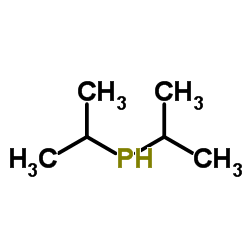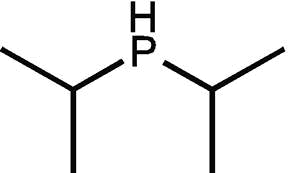二异丙基膦, 99%,Diisopropylphosphine
产品编号:西域试剂-WR114971| CAS NO:20491-53-6| MDL NO:MFCD00233814| 分子式:C6H15P| 分子量:118.16
本网站销售的所有产品仅用于工业应用或者科学研究等非医疗目的,不可用于人类或动物的临床诊断或者治疗,非药用,非食用,
| 产品名称 | 二异丙基膦, 99% |
|---|---|
| 英文名称 | Diisopropylphosphine |
| CAS编号 | 20491-53-6 |
| 产品沸点 | 128.3±9.0 °C at 760 mmHg |
| 产品密度 | 0.800 |
| 产品闪点 | 31.4±18.7 °C |
| 精确质量 | 118.091133 |
| PSA | 13.59000 |
| LogP | 2.48170 |
| 外观性状 | 透明无色溶液 |
| 蒸气压 | 13.0±0.2 mmHg at 25°C |
| 稳定性 | 遵照规定使用和储存则不会分解。 |
| 储存条件 | 密闭于阴凉干燥环境中 |
相关文档
化学品安全说明书(MSDS)
下载MSDS质检证书(COA)
相关产品
| 危害码 (欧洲) | N-C-F |
|---|---|
| 风险声明 (欧洲) | R67 |
| 安全声明 (欧洲) | S9-S16-S26-S33-S45-S61-S62 |
| 海关编码 | 2931900090 |
|
Section 1: Product Identification Chemical Name:Di-i-propylphosphine, 98% (10 wt% in hexanes) CAS Registry Number:20491-53-6 Formula:(C3H7)2PH EINECS Number:none Chemical Family:organophosphine ligand Synonym:Di-iso-propylphosphane
Section 2: Composition and Information on Ingredients IngredientCAS NumberPercentACGIH (TWA)OSHA (PEL) Title compound20491-53-610%no datano data Hexane73513-42-590%50ppm1800mg/m3 Section 3: Hazards Identification Harmful by inhalation, in contact with skin and if swallowed. Inhalation of vapors may depress central nervous Emergency Overview: system. Possible risk of harm to the unborn child and impaired fertility. Primary Routes of Exposure:Ingestion, inhalation, skin, eyes Eye Contact:Contact will cause irritation, redness and a burning sensation. Skin Contact:Causes irritation of the skin. Repeated contact causes defatting of the skin. Harmful by inhalation. Inhalation of vapors may depress the central nervous system causing dizziness, and Inhalation: irritation to the lungs. Ingestion:Harmful if swallowed. May cause gastrointestinal irritation, nausea, vomiting and headache. Harmful by inhalation, in contact with skin and if swallowed. Ingestion may cause nausea and vomiting. Acute Health Affects: Inhalation may cause headache and dizziness. Irritating to skin, eyes and respiratory tract. Chronic Health Affects:Prolonged exposure to high vapor concentrations may cause nerve damage and sensory loss. NTP:No IARC:No OSHA:No SECTION 4: First Aid Measures Immediately flush the eyes with copious amounts of water for at least 10-15 minutes. A victim may need Eye Exposure: assistance in keeping their eye lids open. Get immediate medical attention. Wash the affected area with water. Remove contaminated clothes if necessary. Seek medical assistance if Skin Exposure: irritation persists. Remove the victim to fresh air. Closely monitor the victim for signs of respiratory problems, such as difficulty Inhalation: in breathing, coughing, wheezing, or pain. In such cases seek immediate medical assistance. Seek medical attention immediately. Keep the victim calm. Give the victim water (only if conscious). Induce Ingestion: vomiting only if directed by medical personnel. SECTION 5: Fire Fighting Measures Flash Point:-14.8°F (hexane) Autoignition Temperature:no data Explosion Limits:LEL (1.7%) UEL (7.7%) Extinguishing Medium:carbon dioxide, dry powder or foam If this product is involved in a fire, fire fighters should be equipped with a NIOSH approved positive pressure Special Fire Fighting Procedures: self-contained breathing apparatus and full protective clothing. Hazardous Combustion andIf involved in a fire this material may emit toxic organic fumes and phosphorus pentoxide. Decomposion Products: Unusual Fire or Explosion Hazards: Highly flammable. SECTION 6: Accidental Release Measures If spilled, all personnel must be immediately evacuated and the area sealed off. The material may self-ignite Spill and Leak Procedures:releasing toxic and corrosive fumes of phosphorus pentoxide. Ventilation should be available. If entry into the area is required, personnel should be fitted with self-contained breathing apparatus. SECTION 7: Handling and Storage Store in a tightly sealed container under an inert atmosphere of nitrogen or argon. Keep away from heat. Handling and Storage: Material should be transferred under an inert atmosphere of nitrogen or argon in an efficient fume hood. SECTION 8: Exposure Controls and Personal Protection Eye Protection:Always wear approved safety glasses when handling a chemical substance in the laboratory. Skin Protection:Wear protective clothing and gloves. Consult glove manufacturer to determine the proper type of glove. Ventilation:Handle the material in an efficient fume hood. If ventilation is not available a respirator should be worn. The use of respirators requires a Respirator Respirator: Protection Program to be in compliance with 29 CFR 1910.134. Ventilation:Handle the material in an efficient fume hood. Additional Protection:No additional protection required. SECTION 9: Physical and Chemical Properties Color and Form:colorless liq. Molecular Weight:118.62 Melting Point:no data Boiling Point:no data Vapor Pressure:no data Specific Gravity:no data Odor:pungent and noxious odor Solubility in Water:insoluble SECTION 10: Stability and Reactivity Stability:air sensitive Hazardous Polymerization:no hazardous polymerization Conditions to Avoid:contact with air Incompatibility:oxidizing agents, alkyl halides, and halogens Decomposition Products:carbon monoxide, carbon dioxide, phosphorus oxides and organic fumes. SECTION 11: Toxicological Information No information available on title compound. For hexane--Standard Draize Test(rabbit); 10mg(mild). Inhalation(human); TCLo: 190ppm/8W. Oral(rat); ld50: 28710mg/kg. Inhalation(rat); LC50: 48000ppm/4H. RTECS Data:Intraperitoneal(rat); LDLo: 9100mg/kg. Intravenous(mouse); LDLo: 831mg/kg. Inhalation(rat); TCLo: 2000ppm/12H/24W-I. TDLo: 38g/kg oral(mouse) fetotoxicity: TCLo: 10,000ppm/7H. Inhalation(rat) reproductive, behavioral, newborn; TCLo: 1000ppm/6H. Inhalation(rat) reproductive, newborn, wt. loss; TCLo: 5000ppm/20H. Carcinogenic Effects:Hexane: Insufficient data Mutagenic Effects:Hexane: Possible mutagen Tetratogenic Effects:Hexane: Possible reproductive effector SECTION 12: Ecological Information Ecological Information:Toxic to aquatic organisms. May cause long-term adverse effects in the aquatic environment. SECTION 13: Disposal Considerations Disposal:Dispose of according to local, state and federal regulations. SECTION 14: Transportation Shipping Name (CFR):Flammable liquid, N.O.S. Hazard Class (CFR):3 Additional Hazard Class (CFR):NA Packaging Group (CFR):I UN ID Number (CFR):UN# 1993 Shipping Name (IATA):Flammable liquid, N.O.S. Hazard Class (IATA):3 Additional Hazard Class (IATA):NA Packaging Group (IATA):I UN ID Number (IATA):UN# 1993 SECTION 15: Regulatory Information TSCA:Not listed in the TSCA inventory SARA (Title 313):Title compound not listed. Hexane: reportable under SARA 313. Second Ingredient:Listed in the TSCA inventory. SECTION 16 - ADDITIONAL INFORMATION N/A |








 浙公网安备 33010802013016号
浙公网安备 33010802013016号